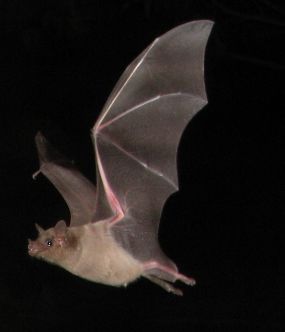Curacao flower bat
| Curacao flower bat | ||||||||||||
|---|---|---|---|---|---|---|---|---|---|---|---|---|

Curacao blossom bat ( Leptonycteris curasoae ) |
||||||||||||
| Systematics | ||||||||||||
|
||||||||||||
| Scientific name | ||||||||||||
| Leptonycteris curasoae | ||||||||||||
| Miller , 1900 |
The Curaçao flower bat, also known as the small long- nosed flower bat or southern long-nosed flower bat ( Leptonycteris curasoae ) is a bat from the leaf-nosed family (Phyllostomidae), which is native to northern South America.
The generic name Leptonycteris is derived from the Greek λεπτός "leptos" (= slender, delicate) and νυκτερίς "nycteris" (= bat). The species name curasoae refers to the island of Curaçao , where the holotype was caught.
description
With a forearm length of 54–55 mm, the Curaçao flower bat is smaller than its sister species Leptonycteris nivalis (forearm length 56.5–59.5 mm). Their fur is gray-brown and darker than that of L. nivalis . In contrast to its second sister species, Leptonycteris yerbabuenae, the tail fly skin is hairy. The ears are relatively small and wide and, like the flight skin, dark brown. Like most representatives of the leaf noses , Leptonycteris curasoae also has a clearly visible nasal leaf . The wings are relatively wide, which makes this species an agile flier that can also hover on the spot.
Way of life
Like most bats, the Curacao blossom bat is nocturnal. It mainly feeds on pollen , nectar and fruits from various cacti and agaves . This diet makes them an important seed disperser and pollinator of many night-flowering plants. Their feed preferences overlap with those of Glossophaga longirostris and, due to their high degree of specialization, make them particularly susceptible to habitat damage. Leptonycteris curasoae occurs in arid and semi-arid regions. Leptonycteris curasoae usually spends the day in caves with a temperature of over 30 ° C and a relatively high humidity of 85% on average. The groups often reach a size of several thousand animals.
Leptonycteris curasoae can live to be over 10 years. Reports of predators are limited to the barn owl and anecdotally to the giant centipede Scolopendra gigantea .
distribution
The Curacao blossom bat occurs in Colombia and Venezuela as well as on Aruba and the Netherlands Antilles . The IUCN estimates Leptonycteris curasoae as endangered ( vulnerable ) because the population size has decreased by more than 30% in the last generation. The reason for this is the exploitation of the caves in which the animals live and the destruction of the habitat.
literature
- FR Cole, DE Wilson (2006) Leptonycteris curasoae. In: Mammalian Species . No. 796, pp. 1-3.
